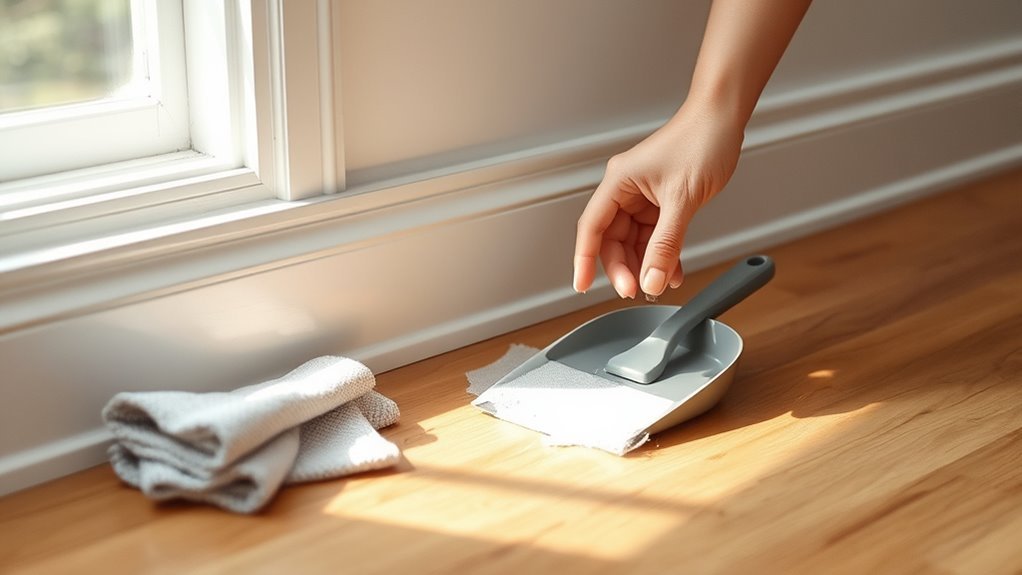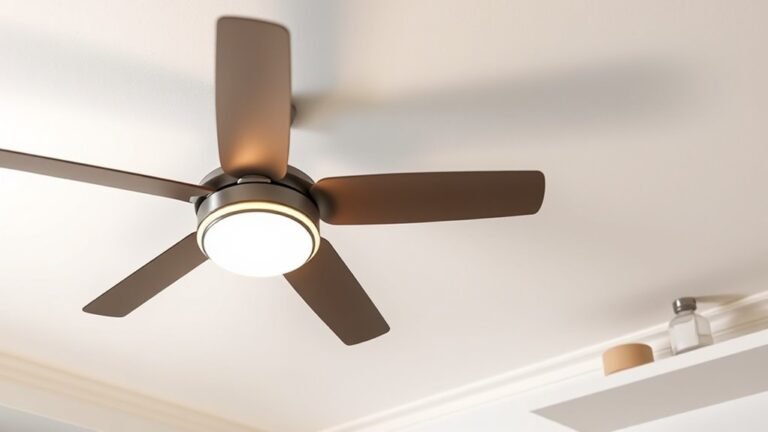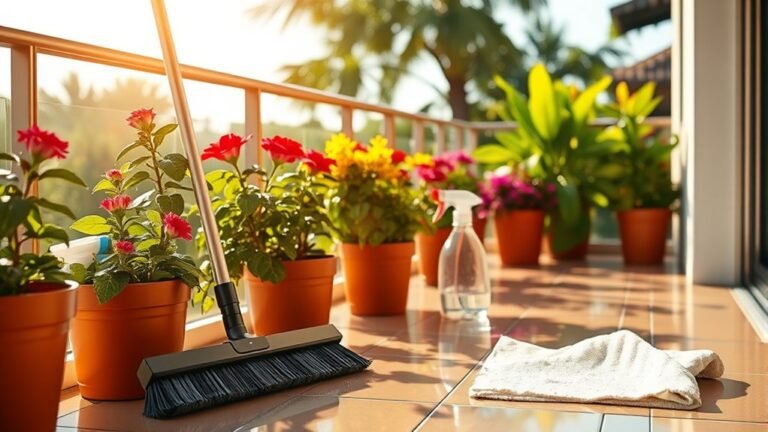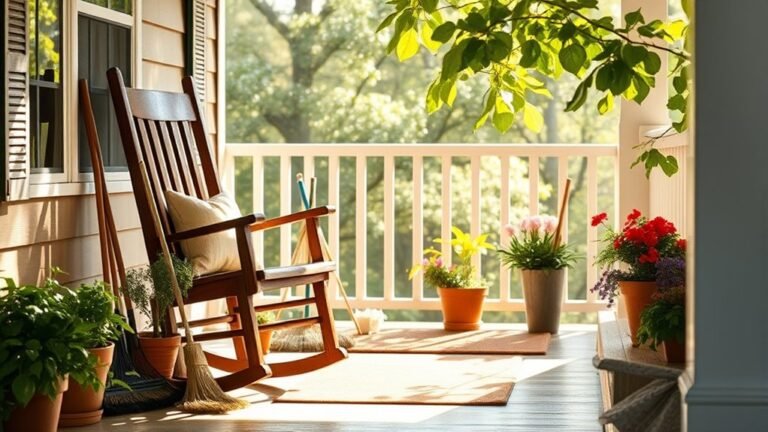Daily Maintenance Tips for Baseboards
To keep your baseboards looking clean daily, dust them with a soft microfiber cloth or duster to avoid scratches, adjusting for the material—wood or vinyl. Spot clean smudges using a damp cloth with mild soap or vinegar solution, and gently remove scuff marks with a magic eraser if needed. Protect your baseboards from furniture damage by using pads and rugs. A quick daily touch-up prevents buildup and keeps them polished. There’s plenty more you can do to maintain their fresh appearance.
Dusting Techniques for Different Baseboard Materials
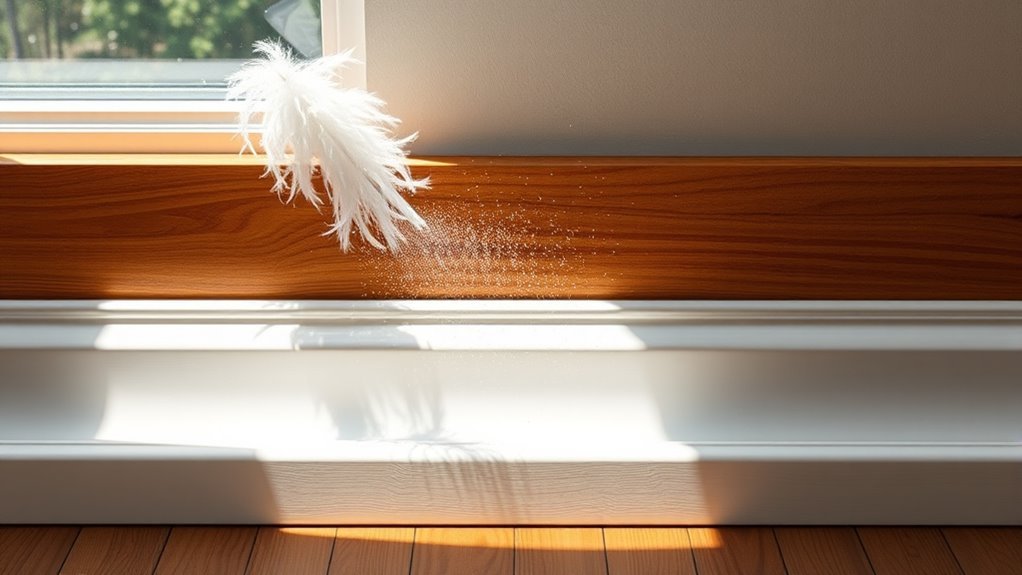
Although dusting baseboards might seem straightforward, the technique you use should vary depending on the material. When dealing with wood baseboards, you’ll want to use a soft microfiber cloth or a feather duster to avoid scratching the surface. Wood is delicate and can easily show wear if cleaned too roughly, so gentle dusting preserves its natural charm. On the other hand, vinyl baseboards are more resilient, allowing you to use a slightly damp cloth without worrying about damage. Just be sure to dry them quickly to prevent any moisture buildup. By adjusting your dusting method to the type of baseboard you have, you maintain their look effortlessly and keep your space feeling open and fresh—just the way you like it.
Best Cleaning Solutions for Painted Baseboards
When cleaning painted baseboards, you’ll want to choose non-toxic solutions that are safe for your home. Look for gentle ingredients that won’t strip or damage the paint finish. Avoid harsh chemicals to keep your baseboards looking fresh without causing wear.
Non-Toxic Cleaning Options
Because painted baseboards can be sensitive to harsh chemicals, you’ll want to choose non-toxic cleaning solutions that effectively remove dirt without damaging the finish. Opting for eco friendly alternatives with natural ingredients lets you maintain your home’s beauty and your peace of mind. Here are four great options you can try:
- A mix of warm water and mild dish soap – gentle yet effective.
- White vinegar diluted with water – naturally cuts through grime.
- Baking soda paste – perfect for tougher spots without harsh chemicals.
- Lemon juice combined with water – adds freshness and cleans well.
These choices give you freedom from synthetic chemicals while keeping your baseboards spotless and safe for your family and pets.
Gentle Cleaning Ingredients
To keep your painted baseboards looking fresh without causing damage, you’ll want to choose cleaning ingredients that are both gentle and effective. Eco friendly alternatives like white vinegar diluted with water or a few drops of mild dish soap can do wonders without harsh chemicals. These options not only protect your paint but also give you the freedom to maintain your home sustainably. Homemade cleaners are a great way to control what touches your surfaces; simple mixes with baking soda and water can tackle stubborn grime without risking damage. By opting for these gentle solutions, you avoid the rigidity of commercial products and embrace a cleaner, freer lifestyle that respects both your baseboards and the environment.
Avoiding Paint Damage
Although it might be tempting to reach for strong cleaners, you’ll want to avoid harsh chemicals and abrasive tools that can damage your painted baseboards. Different paint types and baseboard finishes react uniquely, so treating them gently preserves their look and your freedom from constant touch-ups. Here’s how to keep your baseboards safe:
- Use a mild soap diluted in water for regular cleaning—it’s safe on most paint types.
- Avoid scrubbing pads; instead, opt for a soft cloth or sponge to prevent scratches.
- Test any cleaner on a small, hidden area to verify it won’t harm the finish.
- Steer clear of ammonia or bleach-based products that can strip paint or dull finishes.
With these steps, you maintain your baseboards effortlessly and keep your space looking fresh.
How to Remove Scuff Marks Effectively
Scuff marks on baseboards can be frustrating, but you don’t have to live with them. To remove these stubborn marks effectively, start by using a soft cloth or sponge dampened with warm, soapy water. Gently rub the scuff until it fades, avoiding harsh scrubbing that could damage paint. For tougher marks, try a magic eraser—it’s a powerful tool for effective cleaning without much effort. Always test any cleaner on a small, hidden area first to protect your baseboards. Alongside removal, consider scuff mark prevention by regularly wiping down baseboards and keeping shoes and objects away from them. Taking these simple steps lets you maintain the fresh look of your baseboards while enjoying the freedom of a clean, damage-free space.
Preventing Damage From Furniture and Foot Traffic
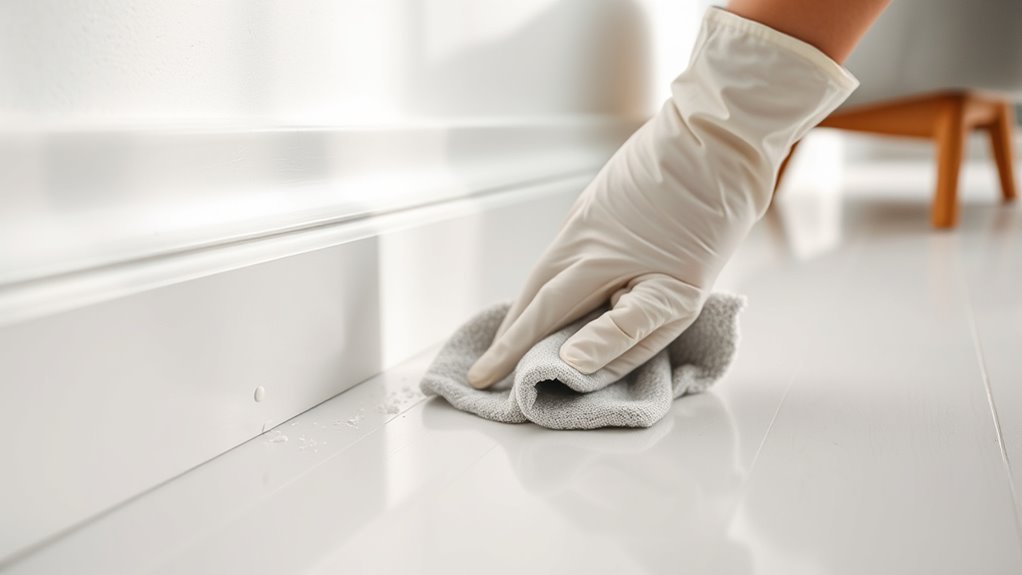
To keep your baseboards looking great, you’ll want to use protective furniture pads to prevent scratches and dents. Placing barriers in high-traffic areas can also reduce wear and tear from constant foot traffic. These simple steps help maintain your baseboards’ appearance for the long haul.
Protective Furniture Pads
One simple way to protect your baseboards from damage caused by furniture and foot traffic is by using protective furniture pads. These small but mighty tools act as a buffer, keeping your baseboards safe while letting you move freely. Here’s how to use them effectively:
- Choose quality furniture sliders or floor protectors that suit your furniture’s weight and floor type.
- Attach pads firmly to the bottom of furniture legs to prevent scratches and scuffs when shifting pieces.
- Regularly check and replace worn pads to maintain continuous protection.
- Use pads on chairs and tables especially in areas with heavy foot traffic to minimize baseboard impact.
High-Traffic Area Barriers
Where do most baseboard damages happen in your home? Usually in high-traffic areas where furniture frequently moves or where foot traffic is heavy. To keep your baseboards looking fresh, use effective baseboard barriers and smart traffic management. These barriers act as shields, preventing dents and scuffs from daily wear.
| Challenge | Solution |
|---|---|
| Scratches from chairs | Install baseboard barriers |
| Frequent foot traffic | Use rugs or mats |
| Moving furniture | Apply protective guards |
| Pet scratches | Use durable barriers |
| Cleaning wear | Regular gentle cleaning |
Using Microfiber Cloths for Gentle Cleaning
Microfiber cloths are a must-have for keeping your baseboards clean without causing damage. Their unique fibers trap dust and dirt effectively, making cleaning effortless. To harness microfiber benefits and master gentle cleaning techniques, try these steps:
- Lightly dampen the cloth to attract dust without soaking the wood.
- Wipe baseboards slowly, following their contours to avoid missing spots.
- Rinse and wring the cloth frequently to prevent redistributing grime.
- Use a dry microfiber cloth afterward to remove any leftover moisture.
Spot Cleaning Tips for Stubborn Stains
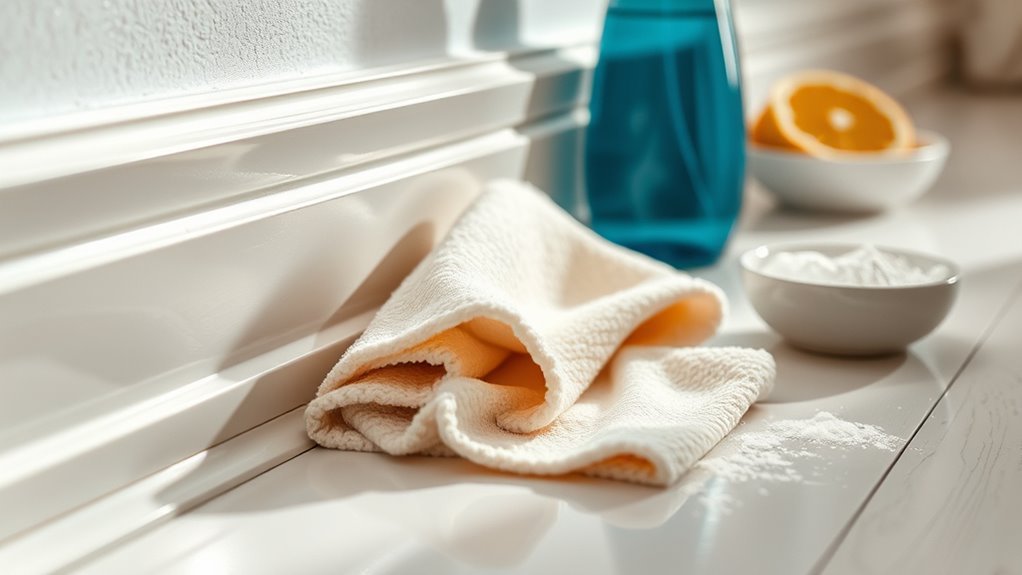
Although regular dusting keeps most dirt at bay, stubborn stains on your baseboards need a more targeted approach. To tackle these, start by identifying common stain sources like scuff marks, crayon, or food spills. Use gentle stain removal techniques such as a damp cloth with mild soap or a baking soda paste for tougher spots. Avoid soaking the baseboards to prevent damage. For scuff marks, a magic eraser can work wonders but test it on a small area first. Always blot rather than rub to protect the finish. By addressing stains promptly and carefully, you maintain your baseboards’ fresh look without sacrificing your freedom to enjoy your space. These simple steps let you handle messes efficiently, keeping your home inviting and well cared for.
Maintaining Vinyl Baseboards Without Harsh Chemicals
Since vinyl baseboards can be sensitive to harsh chemicals, you’ll want to stick with gentle cleaning methods to keep them looking their best. Embracing vinyl care with eco friendly options not only protects your baseboards but also supports a healthier home environment. Here’s how you can maintain them effectively:
- Use a soft cloth or sponge with warm water and mild dish soap to wipe away dirt.
- Mix equal parts water and white vinegar for a natural cleaner that cuts grease without damage.
- Avoid abrasive scrubbers; instead, gently rub to prevent scratches.
- Dry the baseboards with a clean towel to prevent moisture buildup and potential warping.
Scheduling Regular Baseboard Maintenance
Setting a weekly or biweekly schedule for baseboard maintenance can save you time and keep your home looking fresh. By committing to a weekly schedule, you prevent dust and dirt from building up, making each cleaning quick and effortless. You don’t have to feel trapped by endless chores; instead, regular upkeep frees you to enjoy your space without worrying about grime piling on.
To stay consistent, set monthly reminders on your phone or calendar. These prompts help you stick to your routine without stress. You can adjust the frequency based on your lifestyle, but keeping to a plan guarantees your baseboards stay in top shape with minimal effort. This way, your home stays inviting, and you maintain control over your cleaning time.
Quick Daily Touch-Ups to Keep Baseboards Pristine
Even if you stick to a regular cleaning schedule, quick daily touch-ups can keep your baseboards looking fresh between deep cleans. Incorporating simple steps into your daily routines helps maintain baseboard aesthetics effortlessly and gives you more freedom to enjoy your space. Here’s how to do it:
- Dust with a microfiber cloth – It traps dust without spreading it around.
- Spot clean smudges – Use a damp cloth or gentle cleaner on visible marks.
- Check for cobwebs – A quick sweep near corners keeps things tidy.
- Keep a handheld vacuum handy – Use it for quick debris removal.
These small actions take minutes but make a big difference in preserving your baseboards’ pristine look.
Frequently Asked Questions
How Often Should Baseboards Be Repainted for Optimal Appearance?
You’ll want to evaluate repainting frequency based on how much wear your baseboards endure. For ideal baseboard aesthetics, repainting every 3 to 5 years usually does the trick. But if you crave freedom from constant upkeep, just keep an eye out for chips or discoloration and refresh the paint whenever it feels right to you. That way, you’re in control and your baseboards always look sharp without a strict schedule.
Can Baseboards Be Sealed to Prevent Future Staining?
Did you know that sealed wood surfaces can reduce staining by up to 90%? You can definitely seal your baseboards to prevent future staining. Using effective sealing techniques like applying polyurethane or a clear sealant creates a protective barrier, freeing you from constant touch-ups. This way, your baseboards stay cleaner longer, giving you more freedom to enjoy your space without worrying about scuffs or spills ruining their look.
What Tools Are Best for Cleaning Baseboard Corners and Edges?
When tackling baseboard corners and edges, you’ll want to grab some baseboard brushes designed for corner cleaning. These brushes have angled bristles that slip into tight spots, making it easier to remove dust and grime without hassle. You don’t have to be stuck with bulky tools; lightweight, flexible brushes give you the freedom to clean those tricky areas quickly and efficiently, keeping your baseboards looking sharp without any stress.
Are There Eco-Friendly Options for Baseboard Cleaning Products?
Looking for eco-friendly options for baseboard cleaning? Why not choose natural cleaners that are gentle on the environment and your health? You can easily whip up DIY solutions using ingredients like vinegar, baking soda, and lemon juice. These alternatives give you freedom from harsh chemicals and let you maintain a fresh home naturally. Plus, they’re budget-friendly and just as effective for keeping your baseboards spotless and safe.
How Do You Repair Chipped or Cracked Baseboards?
If you notice chips or cracks in your baseboards, don’t stress! Depending on your baseboard materials—wood, MDF, or PVC—you’ll want to choose the right repair techniques. For wood, wood filler or putty works great; for MDF, a lightweight spackling compound is ideal. Sand it smooth once dry, then repaint or stain to match. This way, you keep your space looking fresh without being stuck with complicated fixes.
